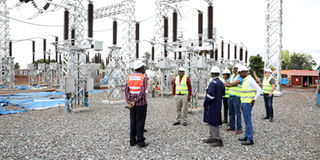UETCL memo links power blackouts to shoddy work

Uganda has experienced a number of power blackouts in the last four months. PHOTO | FILE
What you need to know:
- Uganda Electricity Transmission Company Limited says it has discovered faults at its substations partly attributed to shoddy works by contractors.
It has been established that some of the power blackouts Uganda has been experiencing are because of construction flaws at Uganda Electricity Transmission Company Limited (UETCL) substations.
A UETCL memo seen by Daily Monitor, indicates that the government owned power transmission company recently discovered faults at its substations partly attributed to shoddy works by contractors.
“Recently during a maintenance activity at Namanve, we noticed that the mechanical protection and signals important for monitoring the transformer were all left out by a simple looping wire that was not added by the contractor. This was not the case with the other two transformers that are similar,” Mr Patrick Kawuki, the UETCL principal protection engineer, wrote in a July 27 memo, noting the Isimba transmission line and associated protection at Bujagali and Isimba were incomplete, which caused a nationwide blackout.
The memo also indicated the contractor had since been recalled to correct the anomalies.
The 132 kilovott Isimba dam transmission line, funded by a loan from Exim Bank, was contracted to China International Water & Electric Corporation (CWE).
Mr Kawuki also revealed faults at the recently commissioned Nkenda-Hoima transmission line.
“Nkende-Hoima has issues with pole discrepancy at Nkenda, line automatic re-closure, swapping of differential links for the two lines 1 and 2,” he said.
Re-closure, according to online sources, means the establishment of an interrupted electrical circuit by the closing of a switch or circuit breaker.
In addition, Mr Kawuki revealed that the differential protection for the Fortportal-Hoima line is not stable.
The responsibility to fix the flaws lie with government after the contractor has officially handed over a project.
This means that in addition to the loan repayment obligation, government uses tax payers’ money or money recovered through power tariffs to fix such issues.
Mr Kawuki cautioned that installations and other projects should be thoroughly checked instead of rushing into completion.
Mr Valentine Katabira, the UETCL deputy chief executive officer, in an earlier interview, said they would undertake a system-wide feasibility study on the power system to explore how they can improve reliability as the transmission backbone expands.
UETCL between 2017 and 2019, added to the transmission network 1,263 kilometres of network length bringing the total length to 2,890 kilometres.
Power blackouts
Uganda has had nationwide or partial power blackouts since the onset of the Covid-19 induced lockdown in April.
In April, the blackout was attributed to a moving Island that reportedly blocked the turbines at the Jinja complex.
In May, there was a power blackout in both Kenya and Uganda for a few hours.
On June 21, there was a partial power blackout, which Electricity Regulatory Authority said resulted from a fault from a high voltage line from Kiira Power Station.
This was just before the nationwide black out on July 19, which South African company Eskom, nearing its end of concession in 2023, pegged to a bucket carrier making contact with a high voltage line causing a fault at the 132 kilovott Nalubaale Power Substation.
Eskom has in the past been accused by members of natural resources committee in Parliament of failure to maintain the 66-year-old Nalubaale Dam.
However, Ms Thozama Gangi, the Eskom’s executive director, has previously said the two issues are not related.
Cost of blackouts
Shares surrendered
Depending on which stage of production one is at, electricity blackouts cost manufacturers a lot.
If you are lucky, only your time will be wasted as you reignite the machines that work efficiently at certain temperatures.
“If the produce is already in the system and power goes off, at times you will have waste.
When you have no power and no other alternative, it is a cost because you have to send away workers and you lose material,” Mr Jim Kabeho, the chairperson of Uganda Sugar Manufacturers’ Association explained the cost of power outages and blackouts to manufacturers.
Mr Selestino Babungi, the Umeme managing director, said that based on last year’s Shs1.9 trillion in annual power sales as a sector, they lose about Shs226m for each hour of a blackout.
ERA said it was engaging licensees to improve conditional monitoring to ensure that maintenance activities are done before they escalate to outages or blackouts.




